So, it’s been a while, admittedly, but I never forgot about this project, and now is (finally) the time to get back to it. Right now, I’m hoping to finish Titus Groan by the end of the summer, at which point I’ll figure out a workable schedule for the other two books in the trilogy. I’ve also still got G. Peter Winnington’s biography of Mervyn Peake (Mervyn Peake’s Vast Alchemies) to read as well, and I haven’t decided yet if I want to read it after Titus Groan or wait until I’ve finished the entire series on my own. That is a decision for Future Bridget to make, though. Present Bridget is busy focusing on parsing all the shades of irony, melancholy and sly humor in chapters 32 through 35 of Titus Groan.
Chapter 32: ”The Fir Cones”
“The Fir Cones” is a chapter made of two distinct and disparate parts. The first is a character sketch of Steerpike, largely concerned with how he spends his nights while living with the Prunesquallors. This is followed by the story of the meeting between Lord Sepulchrave, Flay, Nannie Slagg and the infant Titus, a story which ends with a sad commentary on the character of Sepulchrave.
Much of what I call character sketch of Steerpike is, in fact, description of how Steerpike sees himself. Like Fuchsia, Ladies Cora and Clarice, and even Sepulchrave, Steerpike has an intense and active imagination that deeply informs the way he moves through his world, no matter how much he may think of himself as a man of logic with a mind “like an efficient machine.” As Steerpike spends his evenings walking the grounds of the castle, inventing poisons, reading books and polishing his [marvelously phallicly-described] “swordstick,” he’s also scheming and planning, imagining the ways in which he may manipulate Gormenghast’s other inhabitants for his own gain. However, perhaps the most compelling thing about the Steerpike passages in this chapter is the way Peake paints Steerpike as a man of deep contradictions: patient but also short-sighted, full of grandiose ideas but also self-absorbed, brilliant yet superstitious. These kinds of contradictory dual natures seem to be common in Gormenghast, but this chapter and the next are heavily focused on exploring the multitudes contained in their individual characters.
The meeting between Sepulchrave, Flay and Slagg—as observed by (read: spied upon by) Steerpike—contains just a kernel of plot: Sepulchrave wants to have a celebratory breakfast for his son. This is literally the only actual event that occurs in this chapter, and it’s really just exposition about a future event. What this section is about, to the degree that it’s about anything at all, is Sepulchrave, his depression, and his failings as a father. Sepulchrave’s idiosyncratic gift of fir cones to his infant son is about as well-received as one could expect. Nannie Slagg is effervescent in her gratitude, but the cones are of little interest to three-month-old Titus, who simply chews on them a little while the adults talk—or, rather, while Slagg and Flay listen to Sepulchrave’s specific-yet-vague instructions for Titus’s breakfast party.
The chapter ends with Sephulchrave sending Slagg, Flay and Titus away when he becomes overwhelmed with his feelings of anger and inadequacy over what he seems to understand as Titus’s rejection of the gift of fir cones. This is explicitly related to Sepulchrave’s depression, even as Sepulchrave lashes out in anger, externalizing his feelings of shame and failure in a violent outburst only to then double down on the very behaviors that caused his feelings.
“He was too proud and melancholy to unbend and be the father of the boy in anything but fact; he would not cease to isolate himself.”
Sepulchrave isn’t able to fully externalize his feelings, however. The final line of the chapter—“He sat back again in the chair, but he could not read.”—suggests that he is deeply effected by his emotions, to the point that his preoccupation is even preventing him from engaging in his most cherished activity. It’s a wonderfully effective note on which to end the chapter.
Chapter 33: “Keda and Rantel”
“When Keda came back to her people, the cacti were dripping with the rain.”
Let it not be said, however, that Mervyn Peake’s best sentences are final ones. Chapter 33 opens as marvelously as the previous chapter closes and then goes on to end as beautifully, as well. “Keda and Rantel” is Peake’s prose at its best, full of gorgeous imagery and evocative turns of phrase. Peake often subordinates story and plot to moody, atmospheric descriptions of setting, but here he balances these concerns. The story of Keda’s love triangle is a compelling exploration of Keda as a character and a thoughtful rumination on what “freedom” means for a young woman whose choices have been as constrained as hers have been.
Darkness and gloom are common features of Gormenghast, and here Peake combines them with vivid nature, seasonal and weather language to convey Keda’s emotional state as she leaves the castle and returns to the Mud Dwellings. “This was the darkness she knew of,” Peake writes, a sentence simple enough by current standards to be cliché. Similarly, Peake’s explicit way of mirroring Keda’s mood in the weather—at one point, clouds literally part as Keda’s feelings shift—feels unfashionably on the nose. Light and darkness and the changing of weather and seasons are classic natural symbols and metaphors, and Peake utilizes them, but it’s easy for any writer to slip into hackneyed phrases. It’s the less obvious ideas and words that stand out on reading this novel in 2018, such as the way Peake describes Keda’s apprehension about her homecoming and how it changes to something less bleak and more hopeful, or at least alive with possibility:
“This, the very moment which she had anticipated would fill her with anxiety—when the problems, to escape which she had taken refuge in the castle, would lower themselves over her like an impenetrable fog and frighten her—was now an evening of leaves and flame, a night of ripples.”
That last line, “and evening of leaves and flame, a night of ripples,” is particularly lovely, evoking warmth, change, and movement. With the chapter opening with an image of water (albeit not still water), this sentence also positions Keda as a metaphorical stone from whom change reverberates when she enters the place of water. She is an actor whose agency affects her surroundings, which is appropriate in a chapter that centers so closely on her and her decisions, both past and present.
This chapter also functions as an exploration of dual natures, and it’s layered with language to that effect. The Mud Dwellings are a place both comforting and frightening. The dwarf dog that Keda encounters is disgusting, yet lovable. The detailed description of the ancient horse and rider statue that is “the pride of the Mud Dwellers” paints a picture both beautiful and horrifying.
Keda’s predicament, as well—a love triangle in which she must choose between two suitors—points to duality, though Rantel and Braigon don’t represent aspects of Keda’s personality or possible paths for her life in the same heavy-handed fashion that characterizes most more modern love triangle stories. Rather, both men seem to be equally appealing options, and Keda’s preference for each of them is dependent more on which one is in front of her than on any particular qualities the men possess. Keda herself recognizes the tragedy of her situation when Rantel and Braigon determine to duel over her, and the bird motif that’s been so persistent throughout the novel reappears in the final paragraph of the chapter:
“Keda,” she said to herself, “Keda, this is a tragedy.” But as her words hung emptily in the morning air, she clenched her hands, for she could feel no anguish and the bright bird that filled her breast was still singing… was still singing.”
Chapter 31: “The Room of Roots”
This is a chapter mostly about Ladies Cora and Clarice Groan and mostly in their POV, which is an interesting perspective that provides ample opportunities for Peake to showcase his sense of slyly humorous irony. The sisters’ misdirected resentment towards Gertrude is expounded upon some more, but perhaps what’s most compelling about this chapter is the way in which it picks up and carries on the sense of uneasy nihilism that the previous chapter ended with. There’s a growing sense throughout Titus Groan that nothing means anything at all, that events in the book simply happen, that characters simply exist and that the setting—suffused as it is with a sort of timeless, dour gloom—could be any time or place or none. There’s a sort of nonsense logic to it all that obviously recalls the work of Lewis Carroll, a writer of similarly surreal landscapes and characters, though Peake seems somewhat more concerned than Carroll ever was with communicating some kind of truth about the human condition.
The theme of duality continues to be explored through the characters of the twins, and the story of the Room of Roots interestingly combines the bird motif that has continuously threaded throughout the novel with the botanical nature imagery that has appeared in the previous few chapters. The titular Room is dug out from the roots of, presumably, an enormous tree, and Cora and Clarice’s resentment of Gertrude is reiterated to be about the birds that the twins think Gertrude has stolen from them.
The showpiece of this chapter, however, is Clarice’s story about how she tried to humiliate Gertrude by throwing ink on her, only to find that Gertrude was wearing a black dress. It combines all the things that are delightful about Peake’s portrayal of Cora and Clarice: dry humor, irony, nonsense logic, and the implicit suggestion that life is meaningless and struggle against fate is futile.
Chapter 32: “Inklings of Glory”
Chapter 32 finds us back in Steerpike’s point of view as he hatches a plot with the twins to destroy Sepulchrave’s books by burning the library, which makes it about as plot-focused a chapter as any in the book. It also contains Steerpike’s realization that Cora and Clarice truly are both stupid and mad, though he still believes that he can manipulate and control them. It remains to be seen if this is true.
Miscellany:
- One day, I want to write a book on the fantasy trope of things being ancient and unchanging for centuries. It’s one of those tropes that I never thought about as a child and young person but that always reads as absurd to me as I approach middle age. Just the idea that any culture would remain largely in stasis for hundreds of years is patently silly, whether it’s being described by Mervyn Peake or J.R.R. Tolkien or George R.R. Martin.
- So, I guess the “old dark-skinned lady” that is Cora and Clarice’s servant might be the only person of color in the book so far. It’s not surprising, but there’s also not much to comment on here. This is a pretty run-of-the-mill example of the ways in which people of color are included in a lot of medieval-ish fantasy work, and it’s always unfortunate.

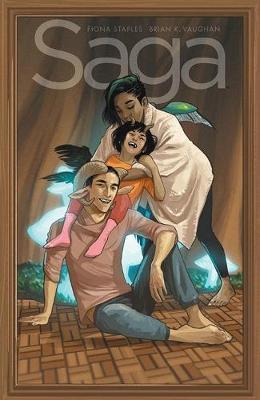 Comics and Graphic Novels
Comics and Graphic Novels

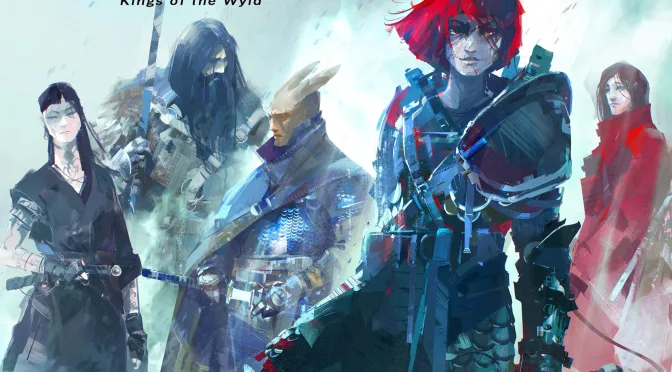
 Nicholas Eames’ freshman novel, Kings of the Wyld, was one of my favorite reads of 2017, a well-written, cleverly observed and often hilariously funny adventure fantasy pastiche that adhered to genre forms while gently poking fun at well-worn tropes and presenting a refreshingly positive and downright heartwarming portrait of non-toxic masculinity in action. So I was pretty hyped to see what Eames would make of this sequel, which showcases a mixed-gender cast from the point of view of a queer teenage girl. Unfortunately, Bloody Rose doesn’t quite rise to the level of excellence of its predecessor, although it’s also by no means a complete failure at the perhaps-too-many things it sets out to accomplish.
Nicholas Eames’ freshman novel, Kings of the Wyld, was one of my favorite reads of 2017, a well-written, cleverly observed and often hilariously funny adventure fantasy pastiche that adhered to genre forms while gently poking fun at well-worn tropes and presenting a refreshingly positive and downright heartwarming portrait of non-toxic masculinity in action. So I was pretty hyped to see what Eames would make of this sequel, which showcases a mixed-gender cast from the point of view of a queer teenage girl. Unfortunately, Bloody Rose doesn’t quite rise to the level of excellence of its predecessor, although it’s also by no means a complete failure at the perhaps-too-many things it sets out to accomplish.



 Collections and Anthologies
Collections and Anthologies Comics and Graphic Novels
Comics and Graphic Novels Magazines
Magazines

 Tor.com Novellas
Tor.com Novellas

 Novels
Novels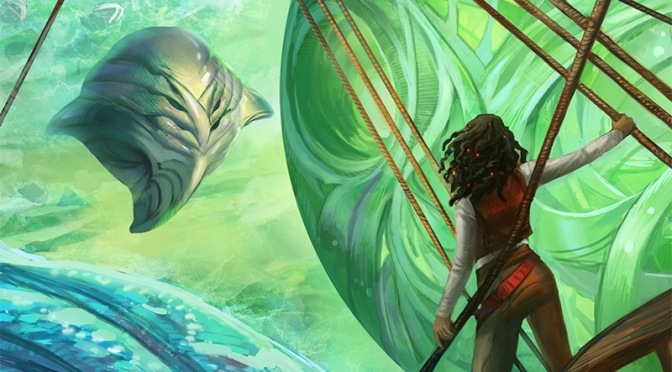



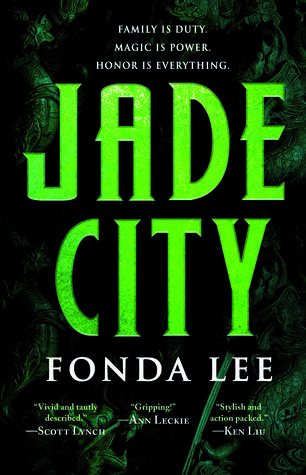 Jade City by Fonda Lee
Jade City by Fonda Lee Kings of the Wyld by Nicholas Eames
Kings of the Wyld by Nicholas Eames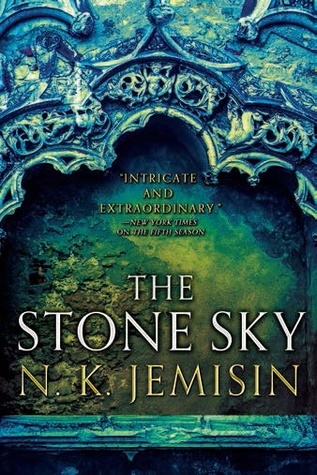 The Stone Sky by N.K. Jemisin
The Stone Sky by N.K. Jemisin Under the Pendulum Sun by Jeannette Ng
Under the Pendulum Sun by Jeannette Ng Crossroads of Canopy by Thoraiya Dyer
Crossroads of Canopy by Thoraiya Dyer Null States by Malka Older
Null States by Malka Older
 Robots vs. Fairies is my first reading disappointment of 2018. I loved Dominik Parisien and Navah Wolfe’s first anthology, 2016’s The Starlit Wood, so I was very hyped for this one when it was announced. Unfortunately, Robots vs. Fairies is a bit of a sophomore slump for the editing pair, with a theme that feels more questionable the farther one reads into the collection, stories that largely feel a little too written to spec, and not enough that’s new and interesting to recommend it on those scores. It might work as sort of comfort reading for those who find its table of contents—filled with some of the hottest short fiction writers currently working in SFF—appealing, but if you’re looking for exciting, fresh, innovative work, there’s not much of that here.
Robots vs. Fairies is my first reading disappointment of 2018. I loved Dominik Parisien and Navah Wolfe’s first anthology, 2016’s The Starlit Wood, so I was very hyped for this one when it was announced. Unfortunately, Robots vs. Fairies is a bit of a sophomore slump for the editing pair, with a theme that feels more questionable the farther one reads into the collection, stories that largely feel a little too written to spec, and not enough that’s new and interesting to recommend it on those scores. It might work as sort of comfort reading for those who find its table of contents—filled with some of the hottest short fiction writers currently working in SFF—appealing, but if you’re looking for exciting, fresh, innovative work, there’s not much of that here.
 So, I’ve finally figured out what it is about Seanan McGuire’s Wayward Children that prevents me from really loving these books the way so many other people do. I just, on a fundamental level, don’t find the fantasy of this series to be an appealing one. I’m slightly distrustful of anything, in general, that smacks of radical individualism, so I’m just not especially taken with the idea that some people are just too special and different for the world they’re born into and must travel to an entirely different world to achieve self-actualization and fulfillment, with the finding and keeping of that world as their personal happy ending. It’s fine. I get it. I think I would have loved this stuff when I was a teenager. In my mid-thirties, however, I struggle with some of the broader implications of it, which impacts my overall enjoyment of the story. I don’t begrudge anyone else the escapist fantasy of a better world of their very own, but my own fantasies at this point in my life are less escapist and more about making this world a better, kinder and more just place for everyone.
So, I’ve finally figured out what it is about Seanan McGuire’s Wayward Children that prevents me from really loving these books the way so many other people do. I just, on a fundamental level, don’t find the fantasy of this series to be an appealing one. I’m slightly distrustful of anything, in general, that smacks of radical individualism, so I’m just not especially taken with the idea that some people are just too special and different for the world they’re born into and must travel to an entirely different world to achieve self-actualization and fulfillment, with the finding and keeping of that world as their personal happy ending. It’s fine. I get it. I think I would have loved this stuff when I was a teenager. In my mid-thirties, however, I struggle with some of the broader implications of it, which impacts my overall enjoyment of the story. I don’t begrudge anyone else the escapist fantasy of a better world of their very own, but my own fantasies at this point in my life are less escapist and more about making this world a better, kinder and more just place for everyone.





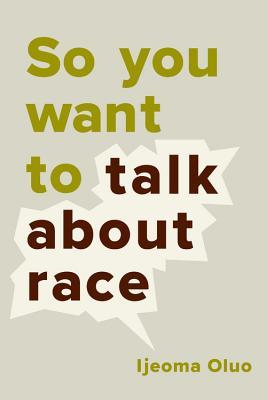 So You Want to Talk About Race by Ijeoma Oluo – 1/16
So You Want to Talk About Race by Ijeoma Oluo – 1/16